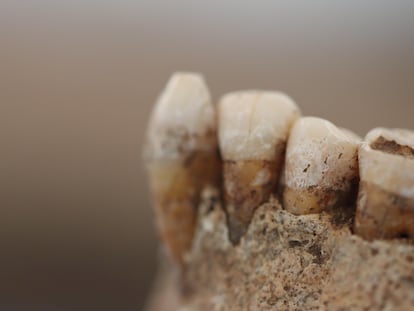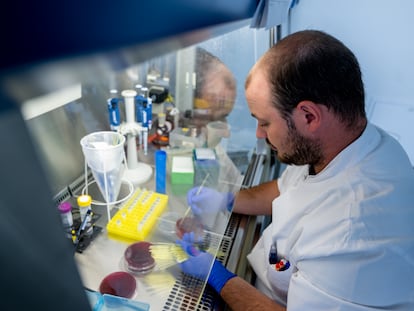How intestinal microbes affect our inclination to exercise
An experiment on mice establishes a gut-to-brain pathway linking some bacterial species with dopamine, which increases the desire to work out

Every so often, research establishes a new connection between the bacteria we carry in our intestines and the rest of the body. Besides being essential to assimilate nutrients, we know the bacteria in our gut is linked to our overall health. Some of these microorganisms have been linked to depression while greater bacterial diversity has been tied to better mental health by some studies. Now, researchers in the US have just discovered a connection between the intestinal microbiome and physical performance, specifically the desire to exercise. The work was carried out in mice, but if it could be replicated in humans, they might have found a way to account for laziness.
The initial objective of the Thaiss Lab scientists at the Perelman School of Medicine at the University of Pennsylvania was to confirm that gut bacteria influence performance during physical activity, as several recent studies on mice and also on elite athletes have shown. While much progress has been made over the years in deciphering the scientific basis of the “high” that runners and many other athletes claim to get when they exercise, several questions remain unanswered, such as do bacteria have something to do with this emotional high? Moreover, does having a particular microbiome make you more inclined to go running?
To address these questions, the team led by Dr. Christoph Thaiss, an assistant professor of microbiology at the University of Pennsylvania, brought together around 200 mice of different strains and made them run, spin on a wheel and walk on a treadmill. In the event, there was a wide range of differences in their performance.
As no link was established between their genes and their performance, other possible causes were examined: their metabolome – set of metabolites generated by the organism – their metabolism and their intestinal bacteria. While neither the metabolome nor the metabolism appeared to affect performance, their gut microbiome did.
What we discovered is a pathway that connects the gut microbiome with an area of the brain that is fundamental for generating motivationChristoph Thaiss, University of Pennsylvania
The role of the intestinal microbiome was discovered using a radical strategy, namely administering a cocktail of antibiotics. As is well known, one of the side effects of treating bacterial infections with antibiotics is that it wipes out the intestinal flora. Researchers observed that the medicated mice’s performance was far worse – up to 50% down on their previous performance and on the performance of the mice that shared their profile. In fact, many did not even go near the treadmill or climb on the wheel.
Thaiss summarizes the results of the research, recently published in the journal Nature: “What we discovered is a pathway that connects the gut microbiome with an area of the brain that is fundamental for generating motivation. The microbiome produces specific metabolites that are detected by sensory neurons that innervate the gut. These neurons are activated during exercise and molecules derived from the microbiome enhance this activation. The sensory neurons then transmit a signal to the brain, which results in an elevation of dopamine levels in the striatum. Dopamine, in turn, is the main neurotransmitter involved in generating the motivation to exercise.” This would be the pathway that connects gut bacteria with the desire to exercise.

The release of dopamine, which is part of the neural reward system during and after exercise, has already been established. What is new is its role in motivation and its connection with bacteria. “The microbiome regulates dopamine levels in the brain,” Thaiss says. “When exercising, these levels increase in the brain, which creates a feeling of pleasure and reward, often referred to as the runner’s high. However, in the absence of the microbiome, this elevation of dopamine is attenuated and, therefore, the feeling of reward from exercise is reduced.” And that’s what was observed with those mice treated with antibiotics – they lost their motivation.
To take advantage of the fact that the treated mice recovered their bacteria and activity levels a few days after treatment, the researchers attempted to identify which bacteria were best connected to the activation of dopamine production and release. To this end, they played around with the antibiotic cocktail, starting with broad-spectrum compounds and gradually narrowing their scope of action, finally managing to limit it to two bacteria: Coprococcus eutactus and Eubacterium rectale, both common in the digestive tract. The disappearance of these two microorganisms was associated with reduced physical activity. Both bacteria produce metabolites known as fatty acid amides. These metabolites stimulate the receptors of the neurons that reach the intestines. Specifically, they activate CB1 endocannabinoid receptors –endogenous counterparts of cannabis compounds – on gut-embedded sensory nerves that complete the pathway to the brain through the spine, causing an increase in dopamine levels in a brain region called the ventral striatum. And as Thaiss said, this is where most motivation comes from.
If replicated in humans, more feasible methods for modifying motivation and mood in other areas could be generated, such as with addiction and depressionNicholas Betley, University of Pennsylvania
Nicholas Betley, an associate professor of biology at University of Pennsylvania and co-author of the study, stated in a press release that “this gut-to-brain motivation pathway might have evolved to connect nutrient availability and the state of the gut bacterial population to the readiness to engage in prolonged physical activity.” For Betley, “This line of research could develop into a whole new branch of exercise physiology.”
The authors of the study believe that if a similar pathway exists between the brain and human gut bacteria, diet-based mechanisms could be offered to make the laziest among us start running while also improving the performance of elite athletes. Furthermore, Betley concludes that the exploration of this pathway might also yield easier methods for modifying motivation and mood in settings such as addiction and depression.
Tu suscripción se está usando en otro dispositivo
¿Quieres añadir otro usuario a tu suscripción?
Si continúas leyendo en este dispositivo, no se podrá leer en el otro.
FlechaTu suscripción se está usando en otro dispositivo y solo puedes acceder a EL PAÍS desde un dispositivo a la vez.
Si quieres compartir tu cuenta, cambia tu suscripción a la modalidad Premium, así podrás añadir otro usuario. Cada uno accederá con su propia cuenta de email, lo que os permitirá personalizar vuestra experiencia en EL PAÍS.
¿Tienes una suscripción de empresa? Accede aquí para contratar más cuentas.
En el caso de no saber quién está usando tu cuenta, te recomendamos cambiar tu contraseña aquí.
Si decides continuar compartiendo tu cuenta, este mensaje se mostrará en tu dispositivo y en el de la otra persona que está usando tu cuenta de forma indefinida, afectando a tu experiencia de lectura. Puedes consultar aquí los términos y condiciones de la suscripción digital.
More information
Últimas noticias
NASA discovers Titan doesn’t have an ocean, but a ‘slushy ice layer’ that increases possibility of life
Innocence lost in the forest of the child soldiers: ‘Each leader of the armed group had his girls’
‘Fallout’ or how the world’s largest company turned an anti-capitalist apocalyptic Western into a phenomenon
From inflation to defending migrants: Eileen Higgins and Zohran Mamdani inaugurate the new Democratic resistance against Trump
Most viewed
- ‘El Limones’ and the growing union disguise of Mexican organized crime
- Christian Louboutin: ‘Young people don’t want to be like their parents. And if their parents wear sneakers, they’re going to look for something else’
- The low-cost creative revolution: How technology is making art accessible to everyone
- ‘We are dying’: Cuba sinks into a health crisis amid medicine shortages and misdiagnosis
- Liset Menéndez de la Prida, neuroscientist: ‘It’s not normal to constantly seek pleasure; it’s important to be bored, to be calm’











































